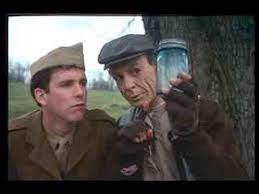All of the fairy tale references in television in this database are categorized by a number from the Aarne Thomspon Uther index. This is an extensive list of mostly European fairy tales. Categorizing tales using these numbers was essential for the software that would show us the prevalence of specific tale types, but it also presented an endless rabbit hole of interesting questions, most of them dealing with the very broad question of what a fairy tale really is. This post will focus on the questions we had about fairy and folk tales that are not European or are not listed in the ATU index.
For the purposes of this database, we decided to include non-European and non-ATU tales that were used in conjunction with or in the same style as tales with an existing ATU. This is obviously very subjective – what is the “style” in which a fairy tale is used? – but we decided based on two factors: first, did the tale come from a folk tale or figure, and second was the tale included in an anthology or episode whose premise was to showcase fairy tales. If a tale met those qualifications and wasn’t included in the ATU, we assigned it a new type of number, or FTT (Fairy Tale Teleography) number.
However, the distinction between a retelling and an original tale type is incredibly blurred. For example, “Soldier Jack” is a popular Appalachian folk tale. Many tales surrounding the originally British folk figure “Jack” originated in the Appalachian region of the United States. However, the plot of Soldier Jack seems to be an amalgamation of two Grimm fairy tales: “the Devil in the Sack” (ATU type 330) and “Godfather Death” (ATU type 332). (http://www2.ferrum.edu/applit/bibs/tales/soldierjack.htm). A case could be made either way, but we eventually listed the episode as type 330 and 332 and not under an FTT number.
Another difficulty associated with assigning FTT numbers is that because these categories are not included in the “canonical” fairy tale index, the person who compiled the database could not have been searching for those specific tales. Therefore, any quantitative analysis of the prevalence of tales will necessarily be swayed towards the (largely European) tale types included in the ATU index. However, despite this and other inevitable inaccuracies, we decided to include most of the non-ATU tales that were already in the database. We did this in the hope that the database will eventually become a truly international list of fairy tales in TV.
Although our database is not yet internationally focused, it is useful in our analysis of contemporary culture to know that popular TV in the United States uses the descriptor of “fairy tale” for non-European tales. It would be interesting to analyze the frequency of these non-canonical tales over time and determine whether the cultural relevance of multinational heritage has increased in the United States. This seems likely, especially given that some of the anthologies listed in the database use more traditional fairy tales but place them in non-European settings.
A list of some of the tale types that we assigned FTT numbers:
– “Hiawatha” in “Shirley Temple’s Storybook.” Hiawatha is a legendary Native American leader (either Onondaga or Mohawk) who helped found the Iroquois Confederacy. FTT 9976
– “Juan Bobo and the Pig” in “Super Why!” Juan Bobo is a popular Puerto Rican folk figure featured in many different tales. In this story he dresses up his mother’s pig; it may be related to the helpful animal tale types . FTT 9968
– “Momotaro and the Peach Boy” in “Super Why!” Momotaro, or “Peach Boy,” is a Japanese folk figure featured in many folk tales, books and films. FTT 9967
– “The Little Red Hen” in “Wolves, Witches and Giants.” This popular story was originally a Russian folk tale. FTT 9965
– “1001 Nights” in many episodes and series. As a compilation of West and South Asian stories, “1001 Nights” obviously includes more than one tale type. However, this collection, like Mother Goose rhymes and Aesop’s fables, is often referenced as a whole in US television. FTT 9994
– “La Llorona” in “Grimm.” La Llorona is a folk tale about a woman who will eternally mourn the death of her husband and/or children. It probably originated in Mexico but is now popular throughout Central and South America. FTT 9962
– “Pom Pom Pom” in “Lea et Gaspard.” This is a French TV series using popular stories and fairy tales to advocate good nutrition. This episode is based on the story of William Tell, a folk figure/hero who originated in Switzerland. FTT 9971
